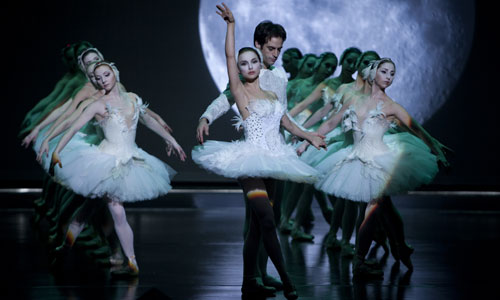[this piece originally ran in the L.A. Times]
Dancer Benjamin Millepied, 33, comes off as a bit of a highbrow pawn in “Black Swan,” Darren Aronofsky’s award-winning ballet-horror film. One imagines his character’s pale hands, lifting Natalie Portman, as dull and mean and clammy. Off-screen, however, Millepied has the world in a wide, warm embrace. Even before “Black Swan” launched his career as a film choreographer-actor and set in motion a whirlwind romance and engagement with Portman, he was gaining international renown for his dancing and his stylish, architectural choreography at New York City Ballet and beyond.
Millepied’s international background (born in Bordeaux, France, and raised in Dakar, Senegal, by a mother who taught dance and a father who trained Olympic decathletes) along with his precocious creative nobility (he was tapped by Jerome Robbins to dance with New York City Ballet at age 16) suggests something of Portman’s own ambitious, multicultural vibe. Listening to the resident of New York City (since his teens), it’s possible to hear a wisp of New Yawk mixed with Millepied’s soft French accent, such as when he talks about the dancing strengths of his wife-to-be. When asked to name his favorite dance moment in “Black Swan,” he immediately answers: “What came off best to me was Natalie.”
On the eve of next week’s DVD release of the film, while riding the train back to New York from a rehearsal with Pennsylvania Ballet, Millepied spoke by phone about the unexpected strength of Portman’s dancing.
“It was so believable, it was fantastic, that beautiful movement quality, ” he says. “There are articles now talking about her dance double [American Ballet Theatre dancer Sarah Lane] that are making it sound like [Lane] did a lot of the work, but really, she just did the footwork, and the fouettés, and one diagonal [phrase] in the studio. Honestly, 85% of that movie is Natalie.”
Although close-ups and CGI were used in “Black Swan,” the film was able to feature long unbroken shots of dance because of Millepied’s choreographic sophistication. How did those dance scenes evoke a classical idiom in steps Portman could achieve? “By making things fluid and not too complicated,” he explains. “By getting more movement going, which in turn added to the camera movement — that is basically what I did. If we had kept things more classical, more restrained, less fluid, it would have been harder to trick the eye.”
Portman’s obviously not dancing much these days: Just before New Year’s Eve, the pair announced that she was pregnant, and by the time he squired her to the Oscars (where she won for lead actress) she needed his arm walking up the Kodak Theatre staircase. And would they ever think of collaborating again on a dance project? “No!” Millepied says, laughing. “I mean I think this was a phenomenal, unforgettable experience. But there are no plans to collaborate again in the future.”
Returning to his home on the East Coast, Millepied headed straight to the country’s foremost dance rehearsal studios. Often compared to Baryshnikov — another dancer rakish enough in a pair of white tights to gain cineplex appeal — Millepied the dance maker has been punished of late by the New York press. Initially the critics embraced the elegance and velocity of his work, yet recently there’s rankling about his ratio of charm to substance and questions of whether he’s delivering on his promise. He remains busy as a choreographer, with a lineup of commissions over the next few years including works for New York City Ballet, Lyon Opera Ballet, Paris Opera Ballet and the Mariinsky Ballet in St. Petersburg, Russia.
After Millepied’s most recent creation, “Plainspoken,” premiered at New York City Ballet in February, New York Times critic Alastair Macaulay described a frustrated longing to like Millepied, yet ultimately called his work “irrelevant” and said he didn’t “feel the least curiosity or desire to see another Millepied premiere, no matter how much more deftly he makes a ballet than most other choreographers today.”
Millepied says that some people get his work, and some don’t. “When ABT did ‘Everything Doesn’t Happen at Once’ in London there was a standing ovation at every performance,” he says. “You have to go with your gut.”
At present he’s got the film bug, bad. Since “Black Swan,” Millepied has co-directed a short film with director Asa Mader (“Time Doesn’t Stand Still”), shot one commercial (unnamed at the moment), recorded two dances for film and is using three live cameras onstage in his work for Pennsylvania Ballet.
“I think directing and choreographing have such a similarity: how to work with movement and motion and narration and emotion and creating images…. And I think having the ability to control the viewer’s perspective on the movement… it’s heaven.”
It’s almost hard to remember that Millepied is still on the roster of principal dancers at New York City Ballet. (“I haven’t been much of a dancer lately,” he says.) He does plan “to do a little more dancing,” he says, though he says that he is mulling over retirement as a performer. His hope is to dance onstage for one or two more years before he stops for good.
Those retirement-concert tickets will surely move fast in New York, just as “Swan Lake” ticket sales have been amped worldwide by “Black Swan.” But before that, he has the challenge of fatherhood this year. Is he excited? “Yes,” he says. “I’m very much looking forward to it. It’s a new life, as everyone who is around me who is a parent tells me. So I’m getting ready.”
